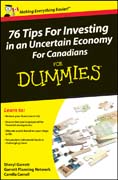
76 Tips For Investing in an Uncertain Economy For Canadians For Dummies
Garrett, Sheryl
Garrett Planning Network,
Cornell, Camilla
This concise, practical guide gives you the strategies you need to confidently protect and strengthen your financial holdings during troubled economic times. Through 76 smart tips, you ll discover how to reduce your investment risk, safely accumulate wealth, and determine how much you ll need for retirement, and how to get there. With tips for everything from improving your credit score to investing through a Tax–Free Savings Account to preparing for financial emergencies, you ll be on the right track toward a safe and sound financial future, no matter what the economic climate. [76 Tips For Investing in an Uncertain Economy For Canadians For Dummies] will be an arms–length away at my desk at the National Post, for handy reference. John Chevreau, The National Post INDICE: Introduction. .Part I: Laying a Solid Foundation. .Tip #1: Keep Your Feet on the Ground. .Tip #2: Realize That This Has Happened Before (And Will Happen Again). .Tip #3: Plan for Life s Uncertainties. .Tip #4: Protect Your Ability to Earn Income. .Tip #5: Assess Your Disability Insurance. .Tip #6: Assess Your Life Insurance. .Tip #7: Take Stock of Your Current Financial Picture. .Tip #8: Save. .Tip #9: Manage Your Debt. .Tip #10: Improve Your Credit Score. .Tip #11: Set and Prioritize Financial Goals. .Tip #12: Don t Let Your Money Beliefs Sabotage Your Goals. .Tip #13: Avoid Common Mistakes in a Down Market. .Part II: Using Investment Vehicles and Accounts throughout the Economic Cycle. .Tip #14: Include Cash Reserves: Savings, GICs, and Money Market Accounts. .Tip #15: Government Bonds: Loaning The Government Your Money. .Tip #16: Decide Whether Fixed Annuities Are Right for You. .Tip #17: Simplify with Target–Date Funds. .Tip #18: Invest in Mutual Funds. .Tip #19: Hedge Your Bets with Segregated Funds. .Tip #20: Invest in Exchange–Traded Funds (ETFs). .Tip #21: Diversify with Real Estate Investment Trusts. .Tip #22: Consider a Wrap Account. .Tip #23: Invest in Individual Stocks. .Tip #24: Invest in Individual Bonds. .Tip #25: Hedge with Options. .Tip #26: Invest in Commodities. .Tip #27: Consider Short–Selling. .Tip #28: Use Caution When Buying on Margin. .Tip #29: Get the Most Out of Your Taxable Accounts. .Tip #30: Invest in Registered Retirement Savings Plans (RRSPs). .Tip #31: Make the Most of Your Employer Retirement Accounts. .Tip #32: Set Up a Tax–Free Savings Account. .Part III: Demystifying Risk: Accumulating and Protecting Wealth. .Tip #33: Understand Investment Risks. .Tip #34: Sort Through an Investment s Return. .Tip #35: Assess Your Ability to Absorb Losses. .Tip #36: Create a Portfolio You Can Grow and Consume. .Tip #37: Allocate Your Assets to Minimize Risk. .Tip #38: Rebalance Your Asset Allocation. .Tip #39: Diversify Your Stock Portfolio by Size. .Tip #40: Diversify Your Stock Portfolio by Valuation. .Tip #41: Diversify Your Stock Portfolio by Country. .Tip #42: Diversify Your Portfolio by Industry. .Tip #43: Diversify Your Bond Portfolio. .Tip #44: Diversify Your Portfolio with Alternative Vehicles. .Tip #45: Employ a Conservative Portfolio. .Tip #46: Employ a Moderate Portfolio. .Tip #47: Employ an Aggressive Portfolio. .Part IV: Investing for Accumulators. .Tip #48: Save for Emergencies. .Tip #49: Provide for Large Expenses. .Tip #50: Plan to Provide for the Kids. .Tip #51: Save for Retirement Regardless of the Shape of the Economy. .Tip #52: Determine How Much Money Is Enough for the Rest of Your Life. .Tip #53: Tips for Beginning Investors. .Tip #54: Investments for Beginning Investors. .Tip #55: Strategies for Intermediate Investors. .Tip #56: Investments for Intermediate–Stage Investors. .Part V: Heading into Retirement. .Tip #57: Be Prepared to Fund Large Expenses. .Tip #58: Consider Working in Retirement. .Tip #59: Use Your Home as a Source of Income. .Tip #60: Understand Retirement Resources. .Tip #61: Make Sure You re Accumulating Enough. .Tip #62: Allocate Assets at the Current Stage of Your Life. .Tip #63: Minimize Your Portfolio Risk. .Tip #64: Manage Your Registered Retirement Plan Investments. .Tip #65: Invest to Supplement Income Needs. .Part VI: Living on Your Investment Earnings and Drawing Down Your Assets. .Tip #66: Benefits Timing: Make CPP/QPP Work for You. .Tip #67: Get the Most Out of Your Pension. .Tip #68: Understand Your Employer Retirement Plan. .Tip #69: Take Stock of Your Registered Accounts. .Tip #70: Use Your Taxable, Partially Taxable, and Non–Taxable Investments Wisely. .Tip #71: Allocate Assets in the Active Stage of Retirement. .Tip #72: Allocate Your Assets for the Slow–Down Stage of Retirement. .Tip #73: Allocate Your Assets During the Late Stage of Life. .Tip #74: Preserve Assets to Pass on to Your Heirs.l .Part VII: The Part of Tens. .Tip #75: Ten Tips for Building a Solid Financial Foundation. .Tip #76: Ten Tips to Minimize Risk. .Index.
- ISBN: 978-0-470-16099-2
- Editorial: John Wiley & Sons
- Encuadernacion: Rústica
- Páginas: 384
- Fecha Publicación: 02/10/2017
- Nº Volúmenes: 1
- Idioma: Inglés
